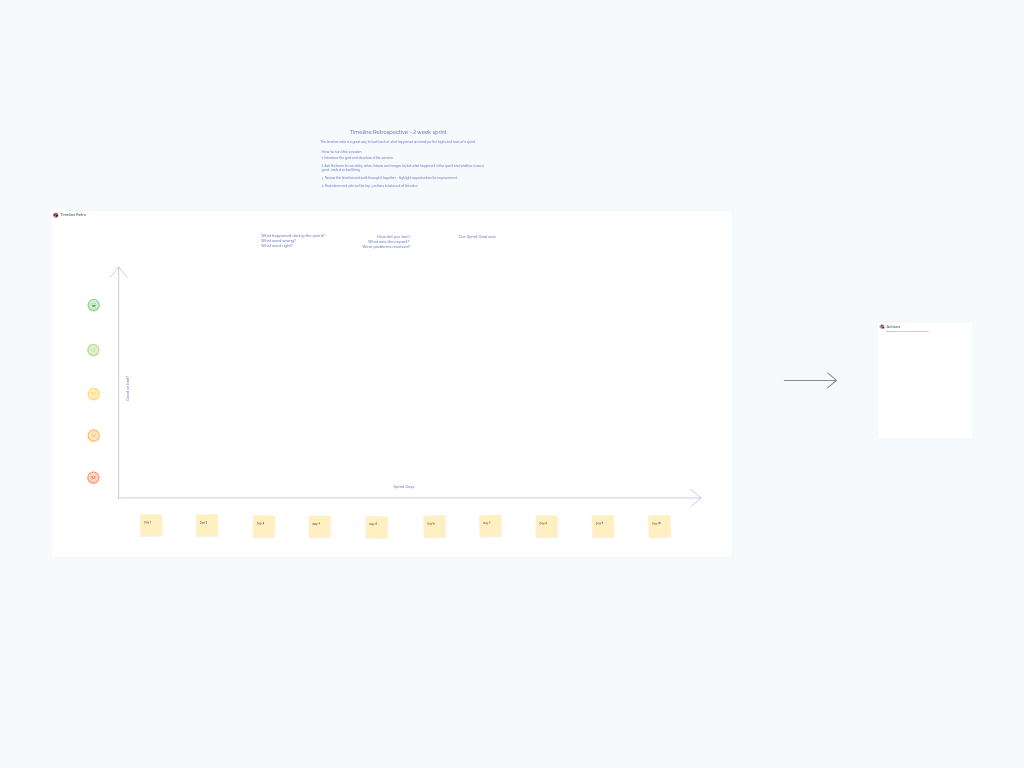Timeline Retrospective
The Timeline Retrospective is a visual, chronological mapping technique that helps development teams track the emotional highs and lows throughout a sprint. By creating a shared visual history of events, teams can identify patterns, understand impact points, and develop targeted improvements for future sprints.
What Is a Timeline Retrospective?
A Timeline Retrospective transforms abstract sprint experiences into a concrete visual representation that shows both what happened and how the team felt about those events. This technique uses a dual-axis approach: a horizontal timeline representing sprint days, and a vertical axis showing the emotional impact of events (from very negative to very positive).
Unlike standard retrospectives that might focus on categories, the Timeline Retrospective emphasizes the flow and sequence of events, making it particularly effective for identifying cause-and-effect relationships and how events influenced team morale over time.
Benefits & When to Use
This retrospective format is especially valuable when:
- Your team has experienced a particularly eventful sprint with many ups and downs
- You want to analyze how specific incidents affected team morale and productivity
- You need to identify patterns that emerge across sprint days
- Teams are struggling to connect events with their consequences
- You want to understand the emotional journey of your sprint
Teams using the Timeline Retrospective gain several advantages:
- Visual clarity on when problems occurred during the sprint cycle
- Better understanding of how events cascade and impact each other
- Insights into which days were most productive or problematic
- A shared narrative that helps team alignment
How to Run a Timeline Retrospective Session
Duration: 60-75 minutes
Introduction (5 minutes)
- Explain the Timeline Retrospective concept and its purpose
- Share the sprint goal for context
- Clarify that the vertical axis represents emotional response (from very negative to very positive)
Individual Reflection (15 minutes)
- Ask team members to add sticky notes to the timeline for significant events
- Encourage them to place notes at the appropriate emotional level
- For each note, suggest including: what happened, why it matters, and how it made them feel
Team Sharing (20 minutes)
- Have the team walk through the timeline day by day
- Discuss clusters of events and emotional high/low points
- Identify any patterns across the sprint days
Analysis (15 minutes)
- Look for cause-and-effect relationships between events
- Discuss how negative events might have been handled differently
- Identify what contributed to positive experiences
Action Planning (15 minutes)
- Brainstorm potential improvements based on timeline insights
- Vote on the top 3 actions to implement
- Assign owners and timeframes for each action
Tips for a Successful Session
- Use colored sticky notes or emoji tokens to quickly indicate positive, neutral, or negative events
- Add photos or screenshots to make the timeline more engaging and memorable
- If using for a two-week sprint, consider consolidating similar days to avoid an overwhelming timeline
- Pay special attention to dramatic shifts from positive to negative or vice versa
- Focus not just on what happened but why it happened and how it made people feel
- For remote teams, ensure everyone can see and contribute to the timeline simultaneously
- Keep the sprint goal visible throughout to provide context for discussions
- Consider using swim lanes for different aspects of work (technical issues, team dynamics, external factors)
By visualizing both events and their emotional impact chronologically, the Timeline Retrospective helps teams understand the narrative of their sprint journey and make targeted improvements for future sprints.



